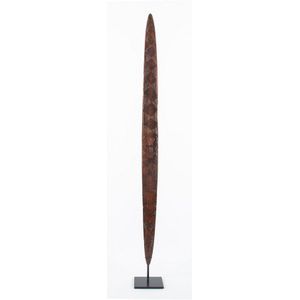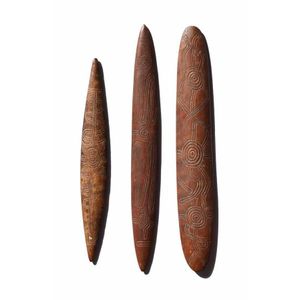Early Parrying Shield from South East Australia
You must be a subscriber, and be logged in to view price and dealer details.
Subscribe Now to view actual auction price for this item
When you subscribe, you have the option of setting the currency in which to display prices to $Au, $US, $NZ or Stg.
- Incised - A record of a name, date or inscription, or a decoration scratched into a surface, usually of a glass or ceramic item with a blunt instrument to make a coarse indentation. Compare with engraving where the surface is cut with a sharp instrument such as a metal needle or rotating tool to achieve a fine indentation.
- Patination / Patina - In broad terms, patination refers to the exterior surface appearance of the timber, the effect of fading caused by exposure to sunlight and air over the course of a century or more, changing the piece to a soft, mellow colour.
As patina is very difficult to replicate, it is one of the most important guides to determining the age of furniture.
Patina is also the term applied to the bloom or film found on old bronzes due to oxidisation.
This item has been included into following indexes:
Visually similar items

An Aboriginal miniature shield, carved wood and ochre, Western Australian origin, early 20th century 32.5 cm long

A message stick, carved wood, West Australian origin 98 cm high

Three Aboriginal Message boards mid 20th century, Central Australia the boards are decorated both sides, with incised circles and geometric designs. Lengths 34 cm. 41 cm & 41.5 cm

A large Papuan Gulf bullroarer Purari Region, Papuan Gulf New Guinea. Height 66 cm.
